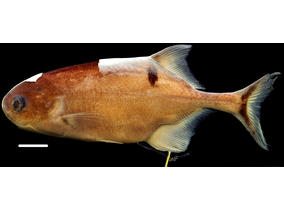You are here
Mormyridae
Petrocephalus zakoni Lavoué, Sullivan & Arnegard 2010
Nomenclature
-
Subfamily: PetrocephalinaeGenus: Petrocephalus
SUMMARY
Petrocephalus zakoni is a small sized species within the genus (maximum standard length = 90 mm). Body ovoid, body 2.5-2.8 longer than high and laterally compressed. Head length between 3.4 and 3.7 times in standard length. Eye large compared to many Petrocephalus species (3.1 ≤ Head length/Eye diameter ≤ 3.3). Snout short and round. Mouth small (4.4 ≤ Head length/Mouth width ≤ 5.0) and sub–terminal, opening under the posterior half of the eye. Teeth small and bicuspid, 6–10 (paratype median = 8, holotype = 9) in a single row in the upper jaw, 18–22 (paratype median = 19, holotype = 20) in the lower jaw. Dorsal and anal fins originate in the posterior half of the body (1.6 ≤ Standard length/predorsal distance ≤ 1.7; 1.6 ≤ Standard length/preanal distance ≤ 1.7). Pre–dorsal distance roughly equal to the pre–anal distance. Dorsal fin with 23–24 branched rays. Anal fin with 27–28 branched rays. Scales cover the body, except for the head. Lateral line visible and complete with 36–38 pored scales along its length. Twelve to 14 scales between the anterior base of the anal fin and the lateral line. Caudal peduncle thin (1.9 ≤ Caudal peduncle length/Caudal peduncle depth ≤ 2.3). Twelve scales around the caudal peduncle.
Skin on head thick, becoming opaque with formalin fixation. Knollenorgans on the head are not clustered into "rosettes" but, instead, appear as isolated receptor pores, the character state observed in the Mormyrinae.
Body uniformly white–silver, with the presence of three characteristic pigmentation marks: (1) a very distinctive black mark just below the anterior base of the dorsal fin on each side, often extending onto the first dorsal rays and making contact over the dorsum with the contralateral mark; (2) a black mark at the base of the pectoral fins; (3) a crescent–shaped black mark centered at the base of the caudal fin on each side, extending onto the upper and lower parts of the caudal fin. Fins otherwise translucent.


